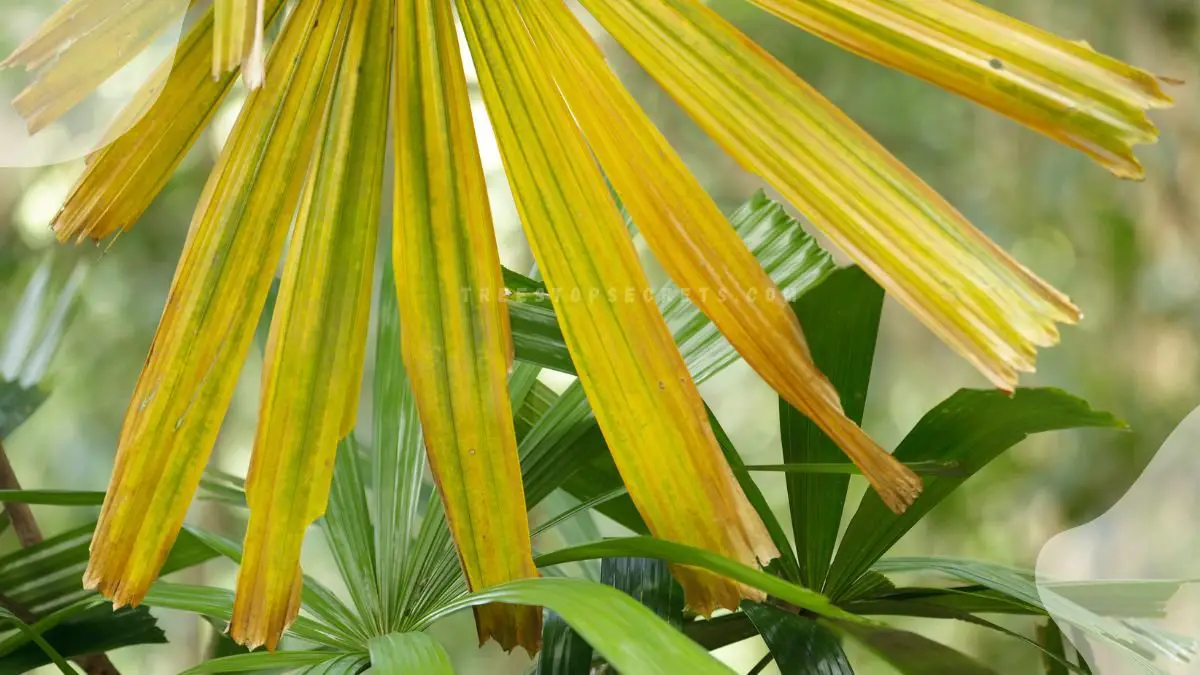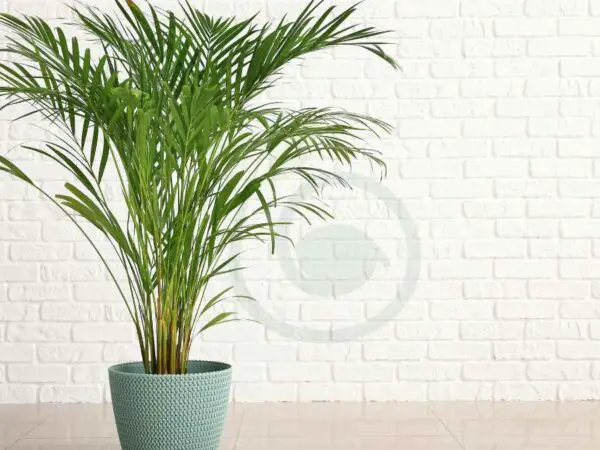If you're concerned about palm leaves yellowing or turning chlorotic, you're not alone. This common issue can affect the health and appearance of your palm trees, but don't worry, we can help. Yellowing leaves often indicate a nutrient deficiency, pest infestation, or improper watering. Our guide will help you identify the cause of yellow leaves and stunted leaves, and provide practical solutions to restore your palm's vibrant green foliage.
Palm leaves yellowing can be caused by several factors. Nutrient deficiencies, particularly a lack of magnesium or potassium, are common culprits. Pests such as spider mites or scale insects can also cause yellowing by feeding on the plant's sap. Additionally, overwatering or underwatering can stress the plant, leading to discoloration. Ensuring proper soil drainage, using a balanced fertilizer, and monitoring for pests can help prevent and treat yellowing leaves. If the issue of yellow palm leaves persists, consider consulting with a horticulturist to diagnose and treat any underlying problems.
We have a wealth of information to help you keep your palm trees healthy and beautiful. Let us guide you through more tips and detailed care instructions for vibrant palm leaves.
Key Takeaways
- Regularly inspect your palm leaves for any signs of yellowing leaves as it can indicate improper light or water issues that need attention.
- Identify the cause: Understand the potential reasons behind yellowing leaves such as overwatering, nutrient deficiencies, or pest infestations to address the problem effectively.
- Tailor treatment to the diagnosis: Once you diagnose the issue, apply specific treatments like adjusting watering schedules, fertilizing appropriately, or using pest control measures as needed.
- Follow palm-specific care guidelines: Implement proper care practices like providing adequate sunlight, well-draining soil, and suitable temperatures to maintain palm health and prevent leaf discoloration.
- Take preventive actions: Proactively maintain good palm care habits to prevent yellowing leaves, such as regular watering, proper fertilization, and monitoring for pests.
- Seek professional help if needed, especially with yellow palm leaves: In cases where basic care strategies are ineffective for your palm tree, consider advanced care options or consult with a plant specialist for tailored solutions about water.
Understanding Yellowing Leaves
Common Causes
Yellowing leaves in palm plants can stem from various factors, including water. Nutrient deficiencies, watering issues, and pest infestations are primary culprits. The combination of these elements often leads to the yellowing of fronds.
Nutrient Deficiency
Nutrients play a crucial role in maintaining palm health. Deficiencies in essential nutrients like nitrogen, potassium, and magnesium can manifest as stunted leaves or yellow fronds. Regular soil testing helps in identifying and addressing these deficiencies promptly.
Watering Issues
Proper watering is vital for palm plants. Overwatering can lead to root rot, causing yellowing leaves due to poor nutrient absorption. On the other hand, underwatering results in dry, yellowish fronds. Adjust watering frequency based on the plant's needs to prevent yellowing.
Pest Problems
Pests pose a significant threat to palm plant health. Insects like spider mites and mealybugs feed on plant sap, leading to yellowed leaves. Implementing pest control measures such as neem oil or insecticidal soap helps in protecting palms from these damaging pests.
Diagnosing Your Palm
Symptoms Checklist
To identify yellowing symptoms in palms, check for pale leaves, yellow streaks, or brown tips. These signs may indicate nutrient deficiencies or pest infestations. Different symptoms, like water, can point to specific problems, aiding in accurate diagnosis and treatment.
- Pale leaves: Lack of essential nutrients like magnesium or iron.
- Yellow streaks: Could signal a potassium deficiency.
- Brown tips: Overwatering or root rot issues.
Assessing Soil Health
Assessing palm soil involves checking moisture levels, compaction, and drainage. Healthy soil is crucial for palm growth, ensuring proper nutrient uptake and root development. Techniques like soil pH testing and organic matter assessment can improve soil quality for optimal palm health.
- Check moisture levels by feeling the soil's dampness.
- Test compaction by observing water absorption rates.
- Evaluate drainage to prevent waterlogging issues.
Identifying Pests
Identifying pests on palms requires keen observation of visible damage, such as holes in leaves or sticky residue. Common pests like spider mites, mealybugs, or palm weevils can harm palms if left unchecked. Early detection and differentiation of pests are key to effective pest management.
- Spider mites: Tiny insects causing webbing on leaves.
- Mealybugs: White, cotton-like pests found on leaf undersides.
- Palm weevils: Large beetles damaging palm trunks.
Treating Yellow Leaves
Adjusting Water
Adjust water levels based on palm care needs to prevent yellowing and maintain overall health. Tailor watering routines to ensure proper moisture levels without overwatering, which can lead to root rot. Implement adjustments gradually to allow the plant to adapt.
l Improvement:
Explore methods to enhance palm soil quality for optimal growth. Enhancing soil drainage by adding perlite or sand can improve aeration and prevent waterlogging, reducing the risk of yellow leaves. Incorporate organic matter like compost for added nutrients.
Pest Control:
Implement effective pest control strategies to protect palm plants from infestations. Regularly inspect the plant for signs of pests such as spider mites or mealybugs. Utilize natural solutions like neem oil or insecticidal soap, or opt for chemical treatments as a last resort.
- Natural pest control options:
- Neem oil
- Insecticidal soap
Sunlight Management:
Understand the significance of sunlight exposure for healthy palm growth. Ensure palms receive adequate sunlight but avoid direct exposure during peak hours to prevent leaf burn and yellowing. Rotate the plant periodically to promote even sunlight distribution.
Specific Palm Care
Bamboo Palm Tips
Bamboo Palms require good palm tree care to thrive. These palms are known for their slender, bamboo-like stems and lush green foliage. To keep them healthy, ensure they are planted in well-draining soil and receive adequate sunlight. Avoid overwatering, as it can lead to root rot. Prune dead or yellowing fronds regularly to promote new growth. Consider using a balanced fertilizer to provide essential nutrients. Healthy palm trees are more resistant to diseases and pests.
Majesty Palm Advice
Majesty Palms are popular for their graceful fronds and tropical appearance. To maintain healthy Majesty Palms, place them in indirect sunlight and water consistently, allowing the soil to dry out slightly between waterings. Majesty Palms are sensitive to overwatering, which can cause root rot. Keep an eye out for palm aphids, common pests that can infest these palms. Regularly mist the fronds to increase humidity levels and prevent browning. Majesty Palms thrive when provided with healthy coconut palms.
Queen Palm Care
Queen Palms, also known as Syagrus romanzoffiana, are elegant trees with feathery fronds. These palms are native to South America and require specific care to flourish. Provide Queen Palms with well-draining soil and ample sunlight for optimal growth. Protect them from frost during colder months, as they prefer warm climates. Regularly trim dead or damaged fronds to maintain a tidy appearance and promote new growth. Fertilize Queen Palms with a slow-release fertilizer designed for palms to ensure they receive essential nutrients.
Preventive Measures
Proper Watering
Palm plants require consistent watering to maintain their health and prevent yellowing. Overwatering can lead to root rot, while underwatering causes dehydration. Ensure the soil is moist but not waterlogged.
To water palm plants effectively, check the soil moisture level regularly. Stick your finger into the soil about an inch deep - if it feels dry, it's time to water. Avoid letting the soil completely dry out between watering sessions.
Soil Quality
The quality of the soil plays a crucial role in the overall health of palm plants. Palms thrive in well-draining soil that allows roots to breathe. Poor soil composition can hinder nutrient uptake and lead to yellowing leaves.
To ensure optimal soil quality, use a well-balanced potting mix specifically designed for palms. Avoid heavy clay soils that retain too much water. Consider adding organic matter like peat moss or perlite for improved drainage.
Regular Maintenance
Regular maintenance is essential for keeping palm plants vibrant and free from yellowing leaves. Tasks such as pruning dead fronds, removing weeds, and inspecting for pests should be part of your routine care regimen.
Create a maintenance schedule that includes regular fertilization, repotting when necessary, and cleaning dust off the leaves. These practices promote healthy growth and prevent common issues like nutrient deficiencies.
Monitoring for Pests
Pests can wreak havoc on palm plants, causing leaves to yellow and overall decline in health. Regular monitoring is key to catching pest infestations early on. Look out for signs such as holes in leaves, webbing, or visible insects.
Inspect both the upper and lower surfaces of palm leaves for any signs of pests like spider mites, mealybugs, or aphids. Consider using natural remedies like neem oil or insecticidal soap to combat pest infestations without harming beneficial insects.
Advanced Care Strategies
Fertilization Techniques
Palm plants require proper fertilization to thrive and prevent yellowing. Use a balanced fertilizer with equal parts of nitrogen, phosphorus, and potassium. Apply the fertilizer every three months during the growing season.
To promote palm health, fertilizers play a crucial role in providing essential nutrients. Nitrogen aids in leaf growth, phosphorus supports root development, and potassium enhances overall plant vigor. Ensure to choose a slow-release fertilizer for gradual nutrient absorption.
Prevent yellowing by following correct fertilization techniques. Avoid over-fertilizing as it can lead to nutrient imbalances and yellowing of palm leaves. Always water the plant thoroughly after applying fertilizer to prevent root burn.
Pruning Best Practices
Pruning is essential for maintaining healthy palm plants. Remove dead or yellowing fronds regularly to promote new growth and prevent diseases. Pruning also helps improve air circulation around the palm.
By pruning palm plants, you can enhance their health by eliminating dead or diseased fronds that can attract pests and diseases. Regular pruning encourages the growth of new fronds and ensures that the plant allocates energy to healthy foliage.
To maintain healthy palms, follow correct pruning techniques. Use sharp, clean pruning shears to avoid tearing the fronds. Cut fronds at an angle to prevent water accumulation, which can lead to fungal infections.
Seasonal Care Tips
Adjust your care routines based on seasonal changes to support palm growth throughout the year. In spring and summer, increase watering frequency to accommodate higher temperatures and faster evaporation rates. During fall and winter, reduce watering to prevent root rot in cooler conditions.
Seasonal care tips are crucial for palm plants' overall health. In warmer months, monitor soil moisture levels regularly and water deeply but infrequently to encourage deep root growth. In colder months, protect palms from frost by covering them with frost cloth or bringing them indoors.
Implementing seasonal care practices ensures optimal growth for palm plants. Consider using mulch around the base of the plant to retain moisture during hot summers and insulate roots during cold winters.
Troubleshooting Guide
When to Seek Help
Knowing when to seek professional assistance is crucial for maintaining healthy palm trees. Look out for persistent yellowing of palm leaves, which could signal underlying issues that require expert intervention. Taking prompt action can prevent further damage and ensure the palm's well-being.
If you notice wilting fronds, stunted growth, or unexplained browning, it's time to consider consulting a professional. Experts can accurately diagnose the problem and provide tailored solutions to revive your palm tree. Timely intervention is key to preventing irreversible damage and preserving the beauty of your landscape.
To address palm issues effectively, seek professional help when standard care methods prove ineffective. Professionals possess the knowledge and experience to tackle complex problems efficiently, ensuring the long-term health of your palm tree.
Professional Assistance
Seeking professional help for palm care offers numerous benefits. Professionals bring specialized expertise in diagnosing and treating various palm issues, ensuring effective solutions. Their in-depth knowledge allows them to identify underlying causes and implement targeted treatments for optimal results.
Professionals can provide comprehensive care for your palms, including fertilization, pruning, and pest control. Their expertise extends to different palm species, enabling them to tailor their approach based on specific requirements. By entrusting your palm care to professionals, you can enjoy lush, vibrant palms that enhance your outdoor space.
Professional assistance is invaluable for resolving complex palm issues that may be challenging to address independently. From nutrient deficiencies to pest infestations, experts have the tools and techniques to restore your palm's health and vitality. Their proactive approach can prevent future problems, promoting the long-term well-being of your palm tree.
Additional Resources
Accessing additional resources can further enhance your knowledge of palm care. Explore online guides, articles, and videos that offer valuable insights into maintaining healthy palms. These resources cover a wide range of topics, from watering schedules to disease prevention strategies.
Recommended sources provide detailed information on palm care best practices and troubleshooting tips. By delving into these resources, you can expand your understanding of palm maintenance and cultivate a thriving garden filled with flourishing palms. Stay informed about the latest trends and developments in palm care to ensure optimal growth and vitality.
Find useful resources that offer practical advice on nurturing your palms, from soil preparation to sunlight requirements. Enhance your gardening skills by tapping into these valuable sources, which serve as essential tools for promoting the health and beauty of your palm trees.
Final Remarks
Now that you've gained insights into why your palm leaves might be yellowing, diagnosing the issue, and implementing treatment and care strategies, you're equipped to ensure your palm stays healthy. By following the preventive measures and advanced care tips outlined, you can maintain vibrant green leaves on your palm plants. Remember, each palm species might have specific care requirements, so always tailor your approach accordingly.
Take action today by applying the knowledge you've acquired to revive your yellowing palm leaves. Regular monitoring, timely interventions, and proactive care will not only enhance the aesthetics of your indoor or outdoor space but also contribute to the overall well-being of your beloved palms. Keep nurturing your plants with the right care, and watch them thrive!
Frequently Asked Questions
How can I identify the cause of yellowing leaves on my palm?
Yellowing leaves on your palm can be due to various reasons like overwatering, nutrient deficiencies, or pests. Check for signs of overwatering such as soggy soil, inspect for pests, and assess the plant's exposure to sunlight.
What are the common treatment options for yellow leaves on palms?
Treating yellow leaves involves adjusting watering habits, providing proper nutrients, and addressing any pest issues. Trim off severely affected leaves, improve drainage if necessary, apply a balanced fertilizer, and use organic pest control methods.
How can I ensure optimal care for my specific type of palm plant?
Specific palm care involves understanding the unique requirements of your palm species regarding light, water, and soil conditions. Research your palm variety for specific care instructions, ensure it receives adequate sunlight, water appropriately, and use well-draining soil.
What preventive measures can I take to avoid yellowing leaves on my palm?
Prevent yellowing leaves by maintaining proper watering schedules, ensuring good drainage, regular fertilization, monitoring for pests, and providing adequate sunlight. Avoid over-fertilizing or overwatering, keep an eye out for early signs of stress, and maintain a healthy growing environment.
When should I consider advanced care strategies for my palm with yellowing leaves?
Advanced care strategies are necessary when basic treatments fail to improve the condition of your palm. If yellowing persists despite adjustments in watering and nutrients, consult with a plant expert or horticulturist for a detailed diagnosis and specialized care plan.
Image Source: Paid image from CANVA





